Tiankengs in the karst of China
Zhu Xuewen and Chen Weihai
Abstract: China has the most extensive and diversified karst terrains in the world and most of them are rich in caves and dolines. The cone karst (fengcong) and tower karst (fenglin) developed in the humid climate in southern China form the most distinctive karst landscapes. Tiankengs are giant dolines that are a feature in some areas of the cone karst. In recent years, more than fifty tiankengs have been discovered in the cone karst in southern China, notably in the provinces of Chongqing, Guangxi, Sichuan and Guizhou. Current research indicates that tiankengs develop in specific environments of geomorphology, geology and hydrogeology, and are therefore distinguished from normal karst dolines.
Keywords: karst, doline, discovery, tiankeng, geomorphology
Introduction
In carbonate rock terrains, one kind of negative karstlandform has not previously been recorded because it is relatively rare and occurs only in more remote regions. It is the great or giant doline, with steep walls and several hundred metres in depth and diameter; it is a collapse doline distinguished by its very large size. This landform was first observed by geologists in China in the early 1980s, in the Xingwen karst in Sichuan, in an area that was being developed for tourism. It was not mentioned in the hydrogeological investigation reports throughout China in 1970s-1980s, and therefore had no scientific explanation.
In the past 20 years, many more of these great karst dolines have been discovered in southern China. Some, including Xiaozhai, Dashiwei, Qingkou and Haolong, have been found by vigorous tourism development that has been searching for spectacular features in the more remote karst areas. Others have been found during explorations by the China Caves Project, and this has led to considerable research to identify the special features of the giant dolines that distinguish them from normal, smaller, dolines.
In the world's karst literature there is extensive discussion on normal doline development, but there is little on the development of giant dolines. One exception is Crveno jezero (Red Lake) in Croatia, which was investigated in summer 1998 (Garasic, 2001), with the important discovery that there is an underground waterway through the bottom of the lake; the water is flowing, and the lake is formed in a chamber that measures 400×300×500 m; the Croatian understanding of a great collapsed doline accords with concepts held in China.
This kind of giant doline is distinguished from normal dolines by its size, and also by major differences in basic characteristics, geomorphic evolution and hydrogeological conditions. The understanding of its geomorphology and its importance matured through the 1990s. In October 2001, it was proposed that this giant doline could be distinguished from normal dolines, and a new term, tiankeng, was proposed for the karst literature (Zhu, 2001).
Tiankengs have also been recorded as giant dolines outside China, including Crveno jezero in Croatia, Minyé in Papua New Guinea, Garden of Eden in Malaysia, and El Sotano in Mexico.
There are two types of tiankeng - collapse tiankengs and erosion tiankengs. The former developed by dynamic underground water flow, while the latter were formed by allogenic surface drainage that fed into an underground river in the karst. Collapse tiankengs are much more widespread and more numerous than the erosional forms.
Distribution of tiankengs in China
Current records show that the tiankengs in the karst of China are mainly in the south of the country, especially in the cone karst terrain, although some lie outside this core zone. The distinctive cone karst of southern China covers an area of about 150,000 km2, mainly in northern and western Guangxi, southern Guizhou, around the Yangtze Gorges, and across southeastern Chongqing, northern Guizhou, southeastern Sichuan, western Hunan and western Hubei, as well as in southeastern Yunnan.
Relationships between tiankeng development and the intense erosional power of underground water explain the spatial relationship between tiankengs and large underground river systems, especially in cone karst areas where cave river systems are very well developed. According to the national hydrogeological investigation in China in the 1970s-1980s, there are 2836 underground rivers within Guangxi, Guizhou, Sichuan, Chongqing, Hunan, Hubei and Yunnan, with a theoretical total length of 13,919 km. It appears that a very important condition for the development of tiankengs is the development of both cone karst and major cave river systems.
The typical cone karst (peak-cluster depression, fengcong in Chinese) is formed in carbonate rocks that are continuous and pure over a stratigraphic thickness of more than 200-300 m, where the adjacent surface rivers are deeply entrenched, where the vadose zone is more than 100-300 m deep, and where the climate is humid and rainy. The most marked hydrogeological feature is a well-developed subterranean river system, and the lack of surface rivers. Cone karst is one of the important environments for development of collapse tiankengs, but this does not imply that tiankengs are formed in all cone karst terrains with cave river systems. Tiankeng development is restricted to sites with favourable hydrogeological conditions and favourable geological structure. The erosion tiankeng is developed by an allogenic surface river where there is a deep vadose zone in carbonate rocks, with good drainage through the karst. Worldwide, tiankengs are rare because large cave river systems in cone karst are less common than they are in the Chinese karst. The important tiankengs discovered so far in China are those described below, and these are located on Figure 1.
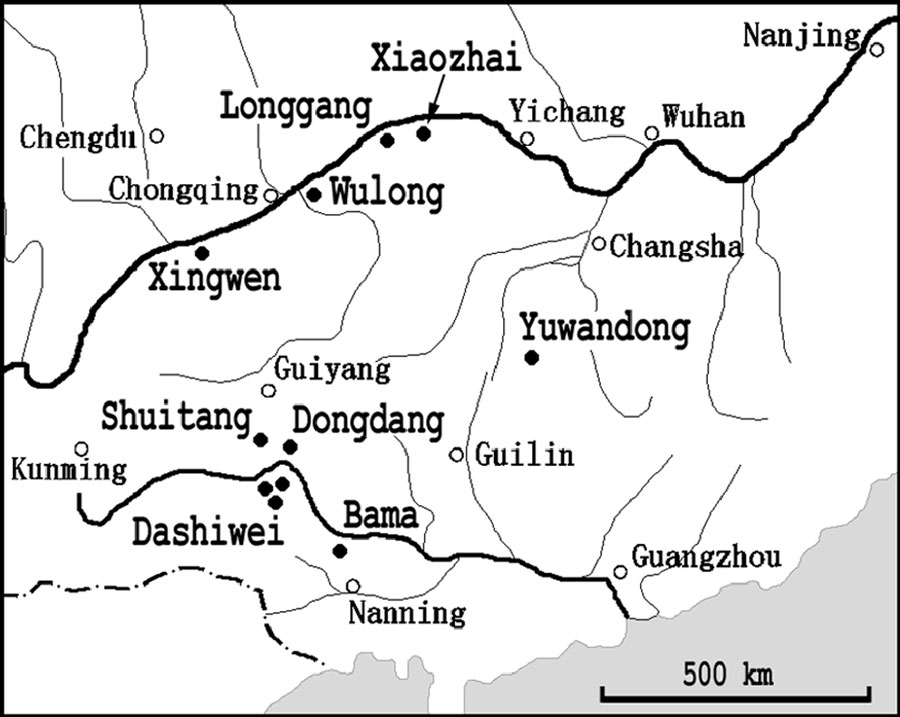
Fig.. 1. Locations of tiankengs in southern China.
The major tiankengs in China
Except for the Xiaoyanwan and Dayanwan tiankengs in the Xingwen stone forest tourism area in Sichuan Province, which have been known for many years, the important discoveries of tiankengs have occurred since 1994. In that year, the largest tiankeng, Xiaozhai, was discovered near the Yangtze Gorges during the search for a new exploration site for British cavers in the China Caves Project. In 2001, a group of 26 tiankengs was discovered in the Leye karst in Guangxi during investigations for karst tourism resources and the search for another venue for cavers on the China Caves Project. The discoveries of this special karst feature generated interest in scientific research, which was pursued in subsequent years. Almost at the same time, Qingkou Tiankeng was discovered by the senior author in the Wulong karst, and was later explored by the Hongmeigui Cave Club. Around its vertical walls there are several hanging waterfalls and these converge on the floor and flow into a large cave passage. Qingkou Tiankeng was the first erosional tainkeng to be recognised. The 49 known tiankengs are listed in Table 1.
Tiankengs are best described as collapse dolines that are more than about 100 m wide and deep, and this is recommended as the internationally accepted definition of a tiankeng (Zhu & Waltham, this volume). There are however many more features that are between 50 m and 100 m deep and wide, and these are already widely known as tiankengs within China; they have been referred to as "small tiankengs" (Zhu, 2001). These include three small tiankengs in the Mengzi basin, within the karst of Yunnan. Though many of these smaller features are very significant karst landforms, they are all omitted from Table 1 and the descriptions that follow.
| Table 1. Dimensions of known tiankengs in China; those with names in italics are degraded tiankengs. | |||||
| Tiankeng | Length xWidth m |
Area m2 |
Depth max m |
Depth min m |
Volume M m3 |
|
Xinlong karst, Fengjie, Chongqing |
|||||
|
Xiaozhai |
625x535 |
274,000 |
662 |
511 |
119.3 |
|
Xiaokeng |
330x180 |
45,000 |
286 |
137 |
12.0 |
|
Chongtianyan |
300x160 |
41,500 |
168 |
103 |
7.0 |
|
Luokuangyan |
135x100 |
10,800 |
101 |
100 |
1.1 |
|
Wujiazhai |
200x150 |
24,000 |
103 |
47 |
2.5 |
|
Daqinkeng |
200x150 |
8,000 |
137 |
66 |
1.1 |
| Qingshui, Yunyang, Chongqing | |||||
|
Longgang |
350x170 |
53,000 |
350 |
250 |
9.2 |
| Houping, Wulong, Chongqing | |||||
|
Qingkou |
250x220 |
40,700 |
295 |
195 |
9.2 |
|
Niubizi |
380x100 |
27,000 |
195 |
100 |
3.5 |
|
Taipingmiao |
180x180 |
26,400 |
420 |
300 |
9.9 |
|
Daluodang |
240x220 |
32,400 |
372 |
282 |
10.4 |
|
Shiwangdong |
170x150 |
25,900 |
252 |
172 |
5.1 |
| Sanqiao, Wulong, Chongqing | |||||
|
Zhongshiyuan |
565x555 |
278,200 |
214 |
75 |
34.8 |
|
Xiashiyuan |
990x545 |
352,100 |
373 |
50 |
31.5 |
|
Qinlong |
520x200 |
194,000 |
276 |
195 |
31.7 |
|
Shenying |
300x260 |
51,200 |
285 |
190 |
9.7 |
|
Xingwen karst, Sichuan |
|||||
|
Xiaoyanwan |
625x475 |
200,000 |
248 |
178 |
36.0 |
|
Dayanwan |
680x280 |
164,000 |
110 |
40 |
15.0 |
|
Dashiwei group, Leye, Guangxi |
|||||
|
Baidong |
220x160 |
22,000 |
312 |
263 |
5.8 |
|
Chadong |
400x350 |
80,500 |
25 |
165 |
13.3 |
|
Chuandong |
370x270 |
73,000 |
312 |
175 |
11.7 |
|
Dacao |
300x140 |
30,000 |
92 |
56 |
1.3 |
|
Dalong |
240x200 |
35,000 |
125 |
95 |
3.3 |
|
Dashiwei |
600x420 |
167,000 |
613 |
511 |
75.0 |
|
Datuo |
530x380 |
149,000 |
290 |
263 |
32.7 |
|
Dengjiatuo |
370x240 |
128,200 |
278 |
222 |
26.2 |
|
Diaojing |
290x280 |
86,300 |
170 |
145 |
12.6 |
|
Gaicao |
440x95 |
24,700 |
120 |
90 |
2.2 |
|
Huangjing |
320x170 |
51,700 |
161 |
140 |
6.3 |
|
Jiameng |
90x80 |
8,800 |
271 |
211 |
1.6 |
|
Ladong |
202x125 |
21,600 |
215 |
146 |
2.8 |
|
Laowuji |
300x275 |
75,600 |
171 |
110 |
8.3 |
|
Longtao |
210x175 |
14,400 |
115 |
95 |
1.4 |
|
Luojia |
140x100 |
10,200 |
128 |
71 |
0.7 |
|
Lanjiawan |
150x115 |
10,700 |
130 |
67 |
0.6 |
|
Shenmu |
370x340 |
70,900 |
234 |
186 |
13.2 |
|
Shizilu |
130x70 |
7,000 |
120 |
90 |
0.6 |
|
Shuijia |
245x135 |
23,700 |
167 |
111 |
2.6 |
|
Xiangdang |
310x230 |
45,000 |
146 |
80 |
12.6 |
|
Bama karst, Guangxi |
|||||
|
Haolong |
800x600 |
320,000 |
509 |
185 |
110.0 |
|
Jiaole |
750x400 |
220,000 |
325 |
283 |
67.0 |
|
Dongdang, Shuitang and Yijiehe groups, Guizhou |
|||||
|
Detian |
200x130 |
20,000 |
145 |
115 |
2.5 |
|
Dachang |
550x180 |
80,000 |
320 |
160 |
10.0 |
|
Bajiao |
280x160 |
24,300 |
195 |
150 |
4.0 |
|
Tongtian |
210x130 |
20,000 |
370 |
360 |
7.2 |
|
Xiaoshui |
180x130 |
13,000 |
230 |
210 |
2.8 |
|
Dacaokou |
920x240 |
140,000 |
220 |
160 |
25.0 |
|
Xiaocaokou |
300x120 |
22,000 |
180 |
120 |
3.3 |
|
Bandong |
190x100 |
15,000 |
240 |
225 |
2.0 |
Tiankengs of Xingwen, Sichuan
These two tiankengs are situated in the stone forest tourism area of Xingwen, in Sichuan Province. They lie within a karst escarpment with an area of 40km2 and an integrated drainage system from the Shunhe river sink to the Donghe resurgence. The karst is developed in limestone and dolomitic limestone of the Lower Permian Qixia and Maokou formations. In September 1992, a British cave expedition team explored the underground river and cave systems to reveal the hydrogeological characteristics of the karst (Waltham and Willis, 1993; Waltham et al, 1993; Zhu et al, 1995). More than 30 km of passages were surveyed in 89 caves; the two longest caves Tianquan Dong (8100 m) and Zhucaojing (8800 m) both have passages opening directly into the sides of the Xiaoyanwan tiankeng.
The Shunhe-Donghe drainage area is a cone karst of low relief, influenced by the carbonate lithology and the low-dip escarpment's stratigraphy, and its vadose zone is 150-300 m deep. The modern hydraulic gradient is 3-5%, and the limestone to sandstone-shale ratio in the catchment is 1:1.08, so that there is abundant allogenic water which is advantageous for tiankeng development.
Xiaoyanwan Tiankeng is roughly circular in plan, 625 m from east to west, and 475 m across; its vertical walls are 60-130 m round the entire perimeter. The maximum elevation on the rim is 870 m, and the lowest point in the tiankeng floor is at 622 m, giving a maximum depth of 248 m, and the total volume is 40M m3 (Fig. 2). The major cave systems of Tianquan Dong and Zhucaojing have large, old, abandoned passages that were parts of the same ancient trunk system, and appear to have a close relationship with the development of Xiaoyanwan Tiankeng. The modern cave river passes beneath the tiankeng at a depth of about 70m below its floor.
Dayanwan lies 400 m to the west of Xiaoyanwan, and is 680 m long east to west, 280 m across, 110 m deep and 15M m3 in volume. It is a heavily degraded tiankeng, with only a gentle slope on its western side and a deep sinkhole developing in its eastern sector; the extensive breakdown and collapse blocks on its floor are partly covered by later alluvial sediment.
The surveys by the British caving team in 1992 (Fig. 3) clearly show two stages of development in the Xingwen caves. The first stage had Tianquan Dong and Zhucaojing developing together, with Dayanwan and Xiaoyanwan being developed at the same time. The second stage has the modern trunk drainage route developing from the Shunhe river sink, with a tributary from the Heping Dong area passing through part of Zhucaojing, all feeding to the modern resurgence at Donghe.
The eastern entrance of Tianquan Dong could have been the entrance for water flowing into the cave in the earlier stage, instead of it being a truncated exit. The large entrance tapers into a passage with sands and pebble beds, and wave scallops point to the west along the main upper passage and then south along the large Southeast Passage. The Dayanwan and Xiaoyanwan tiankengs appear to be older than many of the other tiankengs in China, but cannot yet be dated; clearly Dayanwan formed earlier than Xiaoyanwan since it is so degraded.
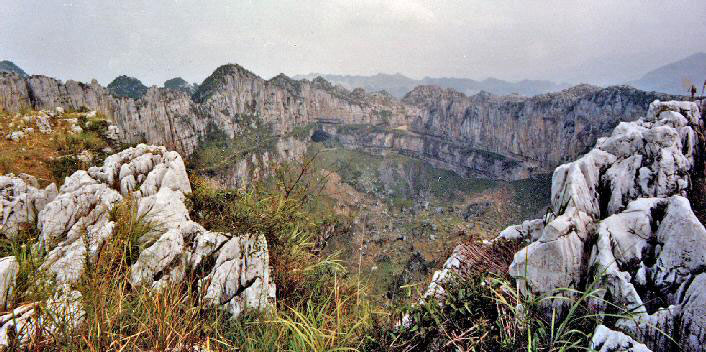
Fig. 2. Xiaoyanwan Tiankeng, Xingwen.
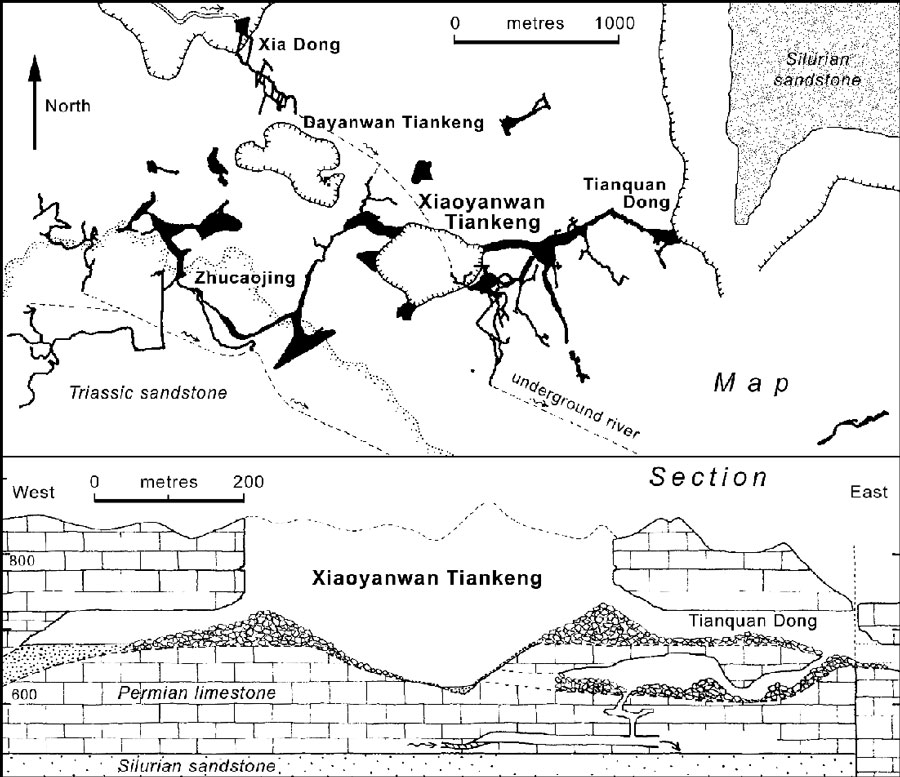
Fig. 3. Xiaoyanwan and the adjacent caves in the Xingwen karst.
Xiaozhai Tiankeng, Fengjie, Chongqing
Located near Xinlong town in Fengjie county, the Xiaozhai tiankeng is in the karst on the right bank of the Jiupan River, a tributary to the Yangtze River. Developed in gently dipping Lower Triassic limestone, the area is a typical cone karst at elevations of 1300-2000 m. Xiaozhai Tiankeng lies in a karst drainage basin with an area of 280 km2 from Maocaoba to the Migong River. This has a broad valley in its upstream section, draining into a deep square-cut gorge and then into the narrow fissure gorge of Tianjingxia in the middle section, before draining underground through Difengdong in its lower section, with a total drop of 1600 m (Fig. 4). The tiankeng is developed over the Difeng cave section (Senior, 1995).
Xiaozhai Tiankeng may rank as the largest tiankeng in the world, with an entrance diameter of 537 to 626 m, a depth of 662 m and a volume of 119.35M m3 (Fig. 5). In profile, it has a double nested structure; the upper bowl is 320 m in depth, and the lower shaft is a rectangle 342 m in depth and 257-268 m across; the sloping ledge between these two parts is formed at the level of a muddy limestone (Fig. 6). Across the floor of the tiankeng, a cave river has a maximum discharge of 174 m3/sec. The sink of this cave river is in the Tianjing fissure gorge, and its resurgence is in a vertical cliff above the Migong River; the length of the underground passage is 8.5 km, with a fall of 364 m, giving a hydraulic gradient of 4.3%. The cave river is a powerful force in removing material from Xiaozhai Tiankeng.
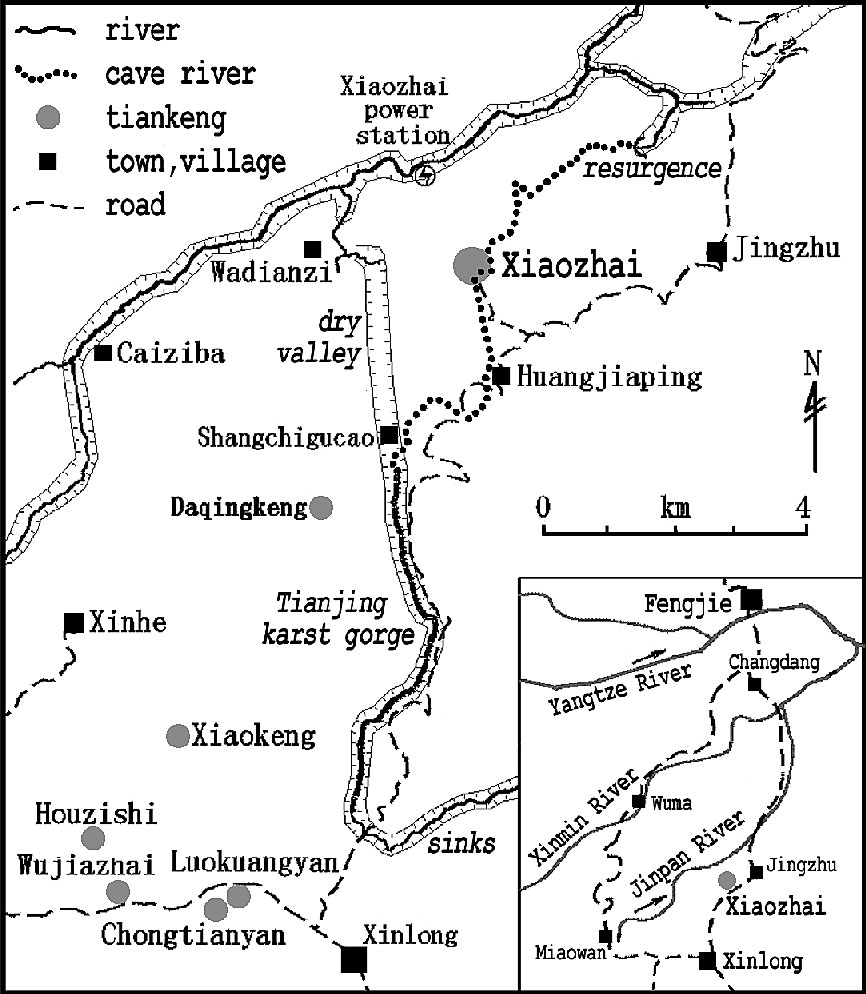
Fig. 4. Xiaozhai Tiankeng, the Di Feng cave and the Tianjing gorge, in the Fengjie karst, Chongqing.

Fig. 5. Air view of Xiaozhai Tiankeng, Fengjie.
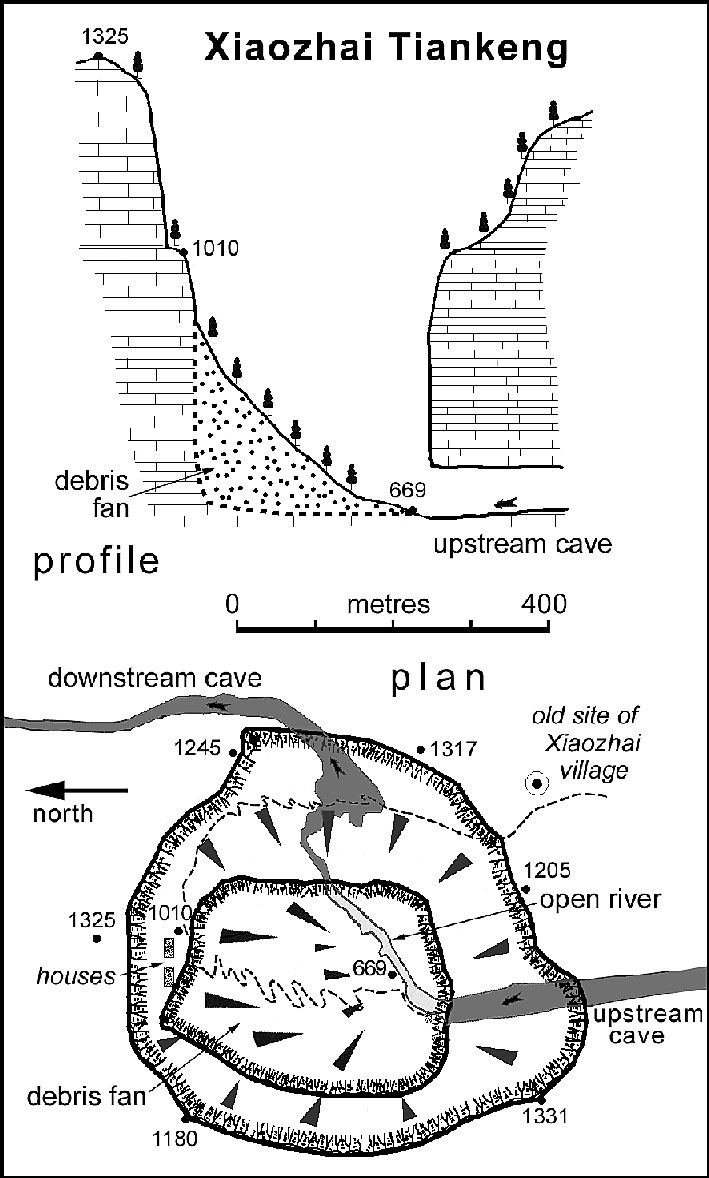
Fig. 6. Plan and profile of Xiaozhai Tiankeng.
Within the karst around Xiaozhai tiankeng there are six other tiankengs of medium-size and 101-170 m deep; these are Chongtianyan, Luokuangyan, Wujiazhai, Houzishi, Xiaokeng and Daqinkeng (Fig. 4; Table 1). They all appear to have developed at an earlier stage than Xiaozhai tiankeng, and all of them are of the collapse type. Longgang Tiankeng lies further west, near Qingshui in Yunyang county, and is distinguished by a very narrow ridge that separates it from an adjacent valley (Fig. 7).
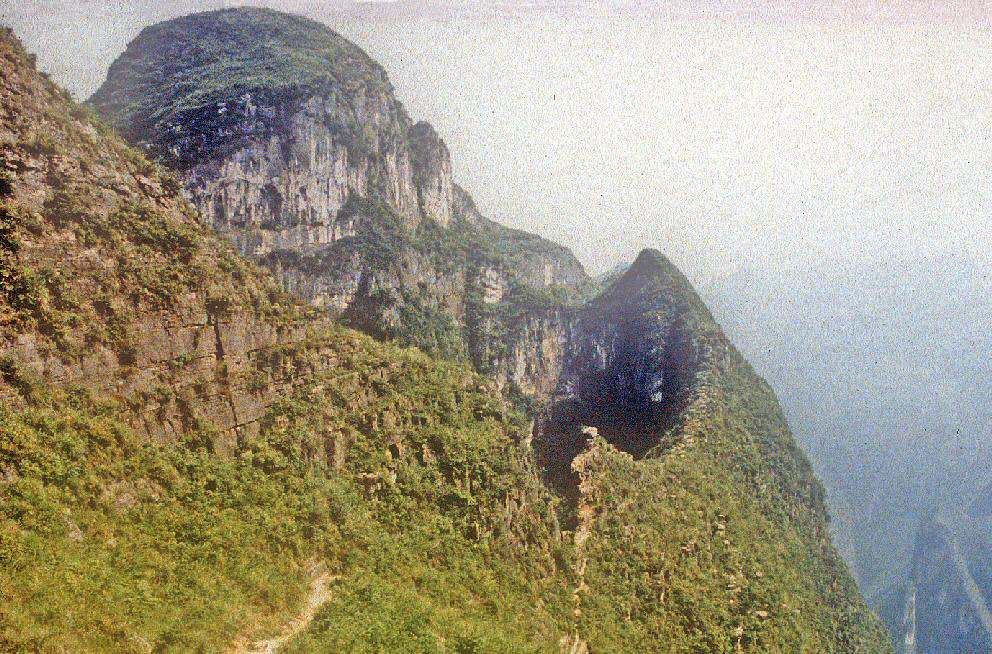
Fig. 7. Longgang Tiankeng in Yunyang county, Chongqing.
Dashiwei tiankeng group, Leye, Guangxi
The Dashiwei group of tiankengs lie in a complex anticline of gently dipping Carboniferous and Permian limestones exposed in a S-shaped inlier beneath Triassic clastic rocks. The karst is drained by the large Bailong underground river, and has a vadose zone that is 400-800 m deep. Cone karst is developed across the carbonate outcrop at elevations of 1300-1500 m, and the site is ideal for tiankeng development (Fig.8).
The large group of tiankengs that includes Dashiwei lies in western Leye county, close to Tongle town (Zhu et al, 2003b). There are 26 tiankengs discovered so far. The largest is Dashiwei Tiankeng, which is pear-shaped in plan, 600 m long from east to west, 420m wide from north to south, 1580 m around the perimeter, and 613 m at its maximum depth. It is surrounded by vertical cliffs (Fig. 9) and its floor is covered by a ramp of collapse debris more than 100 m high that slopes steeply down from east to west and is covered by flourishing secondary forest. The cave river is accessible at the lowest point of the tiankeng floor (Fig. 10), under its western wall; it emerges from a pile of collapsed rocks, and 6000 m of passage has been mapped downstream, as far as a point where the river drops into deep, narrow and inaccessible fissures.
All the tiankengs in the Dashiwei group are of the collapse type, though Huangjing Tiankeng has been modified by allogenic water, since its collapse development, and is intermediate to an erosional type of tiankeng (see below). Of the 26 tiankengs in the Leye karst, Dashiwei is classified as a very large tiankeng. Chuandong, Datuo and Dengjiatuo are all large, though only Chuandong Tiankeng has vertical walls on its entire perimeter, while the other two have degraded to leave debris slopes round about half their perimeters. These and 17 other tiankengs of normal size are listed in Table 1. The other five sites each have some dimensions less than 100 m; they would therefore be described only as very large collapse dolines in the international context (Zhu & Waltham, this volume), though they are known locally as small tiankengs. These six do include some significant landforms; Yanzi Tiankeng is a fine open shaft into the roof of a large chamber, but it only opens to larger dimensions offset from the entrance.
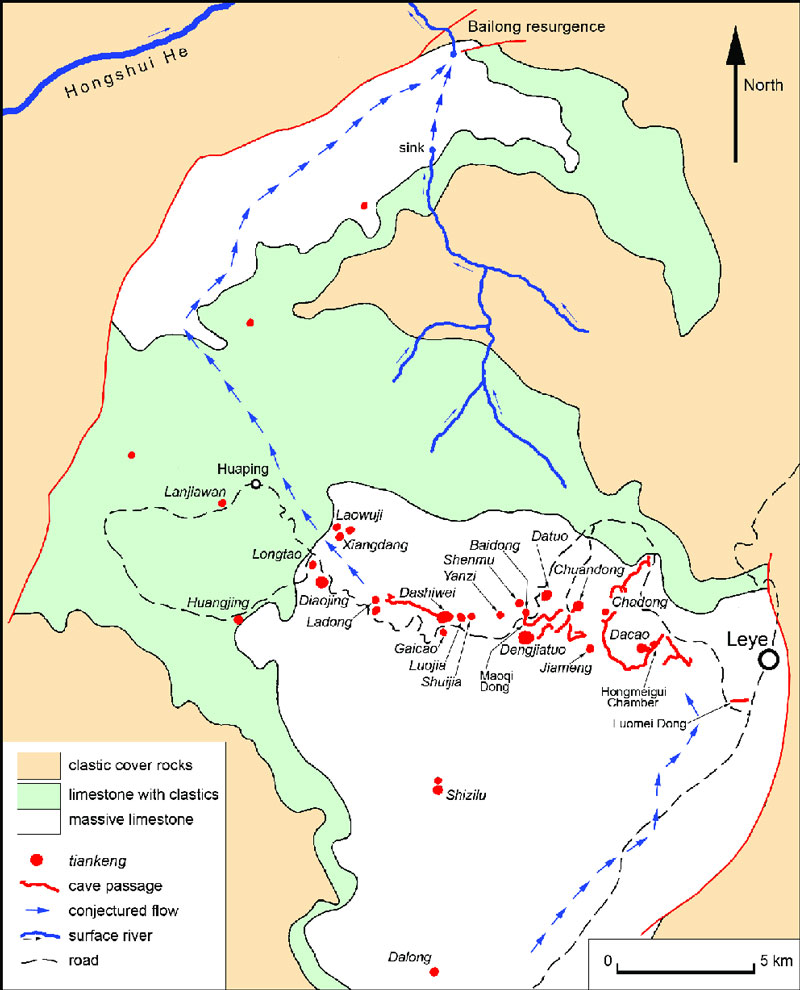
Fig. 8. Tiankengs of the Dashiwei group and the Bailong underground river system within the Leye karst (Guangxi); only marginal faults, some major cave passages and selected roads are indicated; the exposed karst continues to the south.
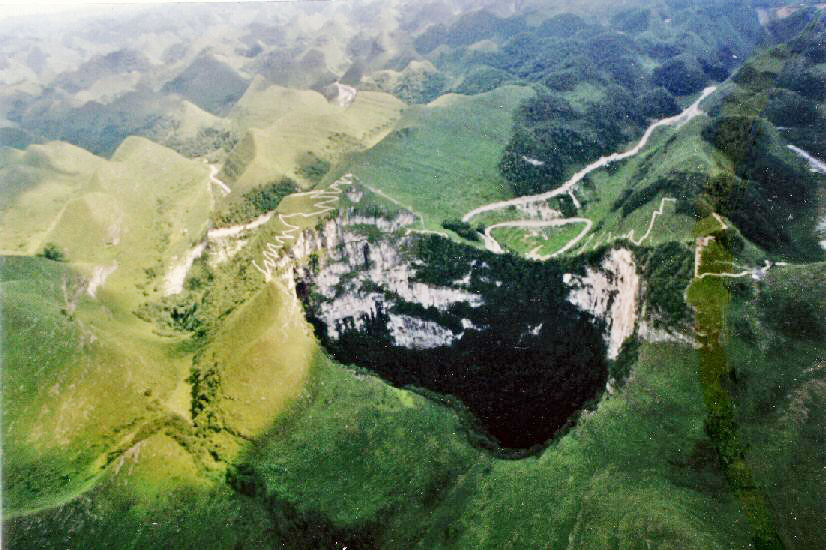
Fig. 9. Air view of Dashiwei tiankeng, Leye.
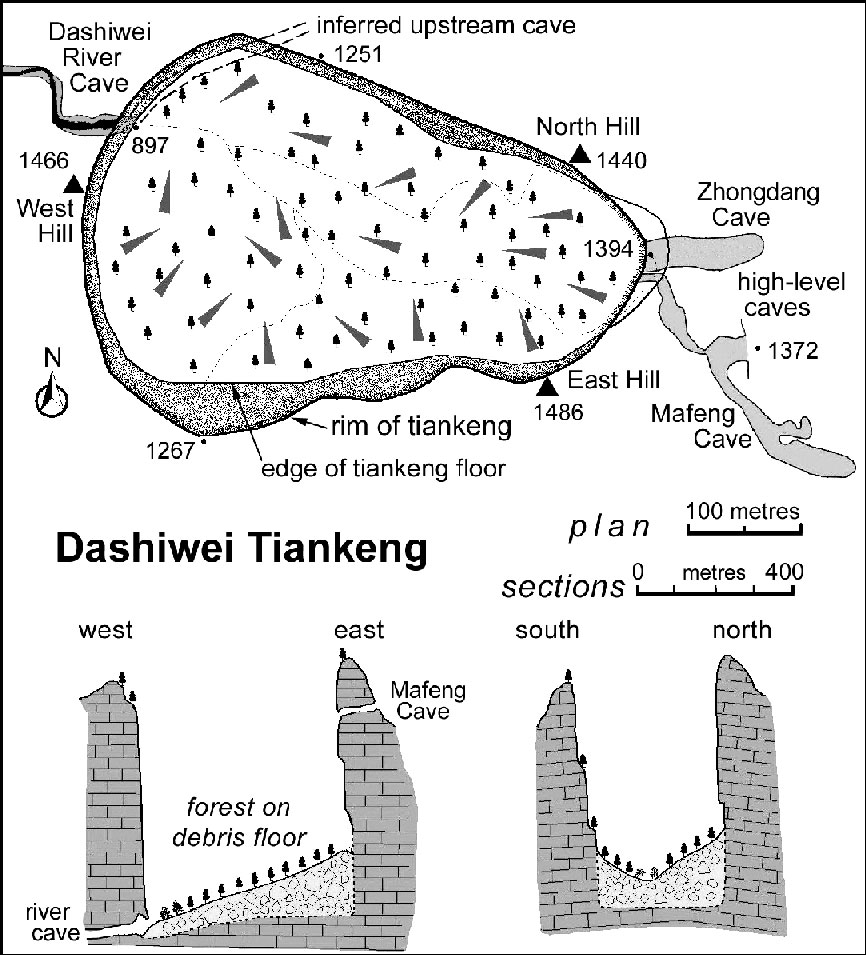
Fig. 10. Plan and profile of Dashiwei Tiankeng.
The main features of the Dashiwei group are very significant to the study of collapse tiankengs -
- A large number of tiankengs lie closer to each other than do others in China;
- The tiankengs lie mainly over the middle section of the Bailong underground river, of which just parts of the river passage have yet been mapped;
- The tiankengs that lie at higher elevations are more degraded and may be older.
- The larger tiankengs lie along the course of the active underground river;
- The ratios of entrance area to floor area of most of the tiankengs is close to unity, due to the almost vertical walls;
- The tiankengs are clearly unrelated to the surface topography of the karst, and their growth has therefore destroyed a variety of surface karst landforms, including dolines, depressions and dry valleys, as well as peaks, hills, cones and mountains;
- Baidong Tiankeng is adjacent to the large chamber with the Maoqi Dong skylight entrance in its roof, and Dacao Tiankeng is adjacent to the large Hong Meigui Chamber in the same cave system;
- The Dashiwei group shows the stages of development from an underground river passage to a cave chamber to a tiankeng;
- Primary or secondary forest develops on the collapse debris in the tiankengs.
Tiankengs at Bama, Guangxi
Haolong Tiankeng lies northeast of Longzhong village in Bama county, Guangxi, and is one of the largest tiankengs in the world. In plan it is 800 m long from east to west and 600 m wide, with a maximum depth of 509 m and a volume of 110M m3. A river flows across the tiankeng floor from west to east. It has developed partly in a large dry valley aligned from east to west, so that only its northern half retains spectacular vertical walls (Fig. 11); its southeastern half is largely degraded, so that is now exploited as fields by the local farmers and the primary forest has been destroyed (Fig. 12).
Jiaole Tiankeng lies 2 km southwest of Haolong. It is 750 m long from south to north, 400 m wide, and 283 m deep, with a volume of 67M m3; a karst dry valley is developed across it from east to west. The tiankeng has the shape of a boat, and is distinguished by a clean-cut vertical wall across its northeastern side as the result of collapse guided by a major fracture. The cave river is exposed to daylight for more than 200 m across the tiankeng floor (Fig. 11).
Both these tiankengs are developed along an old course of the Laolongdong River; part of this survives as the Laolong cave, with a passage that once carried a large allogenic river into the karst.
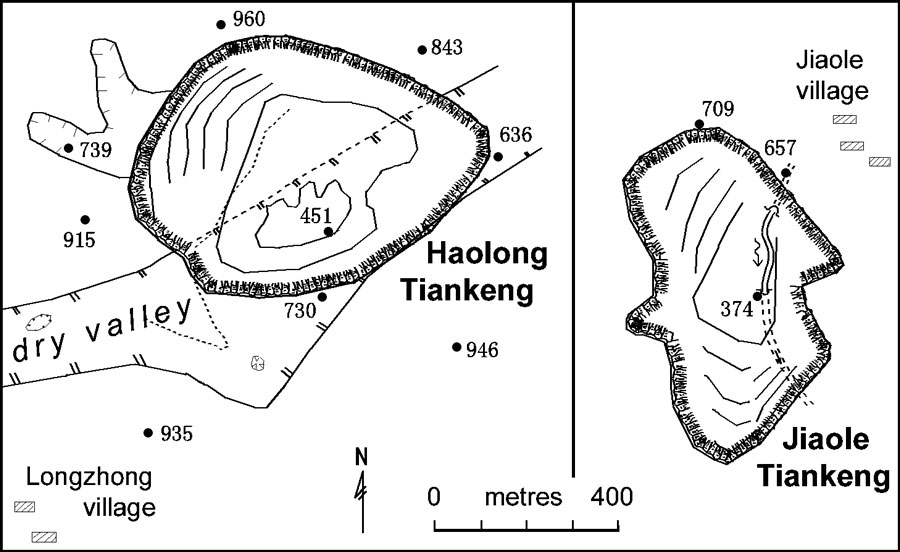
Fig. 11. Plans of the Haolong and Jiaole tiankengs, Bama.
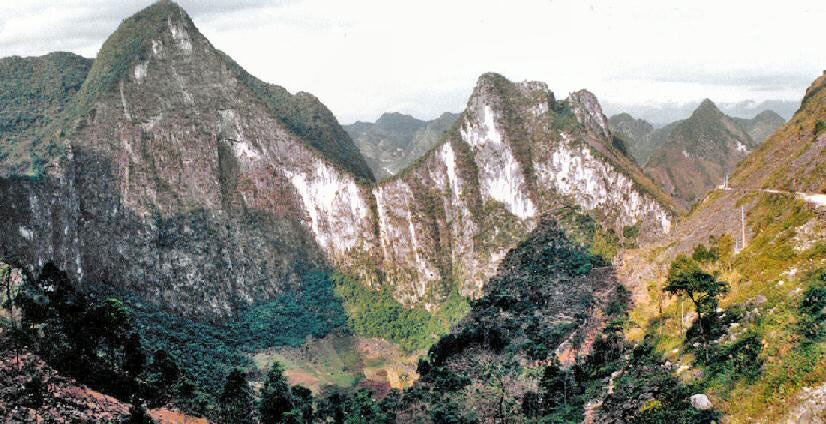
Fig. 12. Haolong Tiankeng, Bama.
Tiankengs of Wulong, Chongqing
Around Wulong, the terrain along the banks of the Wu Jiang, a tributary of the Yangtze River, is a typical fengcong cone karst that is deeply dissected by a river valley. The major local relief creates a vadose zone up to 1000 m deep in the succession of carbonate rocks of Cambrian, Permian and Triassic age. This karst contains Qikeng Dong, which is 920 m deep and is the deepest cave yet found in China.
A number of collapse tiankengs have been recognised in the karst of Wulong county, in the natural bridges tourism area and close by it. The most important are Zhongshiyuan, Xiashiyuan, Qinlong and Shenying Tiankengs. Xiashiyuan is the largest of the tiankengs and is 1 km long. Both the Qinlong and Shenying Tiankengs developed in the dry valley that originated as a major cave passage over 2 km long and is now spanned by three natural bridges (Fig. 13). It appears to be a youthful feature that dates from the late Pleistocene or the Holocene. With its underground river, natural bridges, tiankengs, dry valleys, caves and shafts, this site clearly shows the development stages and typical evolution relationships between the different karst landforms (Fig. 14). Xiashiyuan and Zhongshiyuan Tiankengs both have vertical perimeter walls and are large enough to each contain small villages (Fig. 15); their floors down to small areas at their lowest points, and their nature requires further investigation (Fig. 16).
Qingkou Tiankeng is the finest example of an erosional tiankeng yet discovered in China. It has been formed by a concentrated flow of allogenic surface water draining into karst with a deep vadose zone. It lies within an extensive outcrop of gently dipping, Palaeozoic sandstone and shale on the watershed between the Wu Jiang and the Chang Jiang (Yangtze River) near Houping village. The terrain is incised by dendritic valley systems, so that almost all the surface water drains into a north-south trough valley floored by an inlier of thick, Lower Ordovician limestone. The limestone aquifer was deeply entrenched by the Muzong River in the south to create a deep vadose zone, which provides a very advantageous geological and hydrogeological environment for the development of erosional tiankengs.
The tiankengs of Qingkou, Niubizi, Daluodang and Taipingmiao were developed at the sandstone-limestone boundary within a broad valley (Fig 17). Of these, Qingkou Tiankeng is the largest and most mature (Fig. 18); it is 250 m wide across and 295 m deep (Table 1).This type of tiankeng differs from the collapse form because it has been formed by erosion from the surface into the limestone vadose zone by an allogenic surface stream. It is the less common type of tiankeng. Caves have developed at different levels in the Qingkou tiankeng karst, and a cave system about 10 km long discharges southward to the Mawandong rising of the Muzong River (Fig. 17).
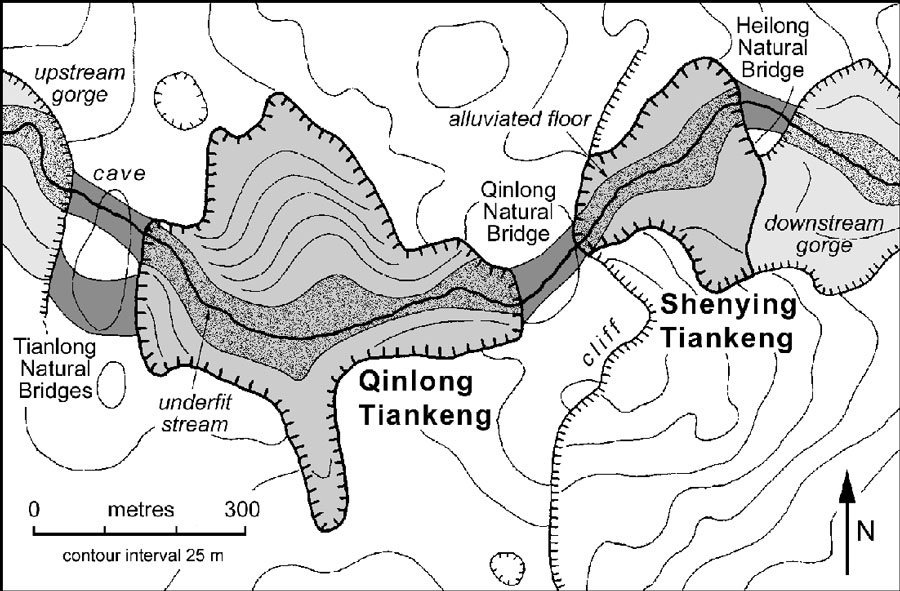
Fig. 13. Qinglong and Shenying Tiankengs between the three natural bridges in the Wulong karst.
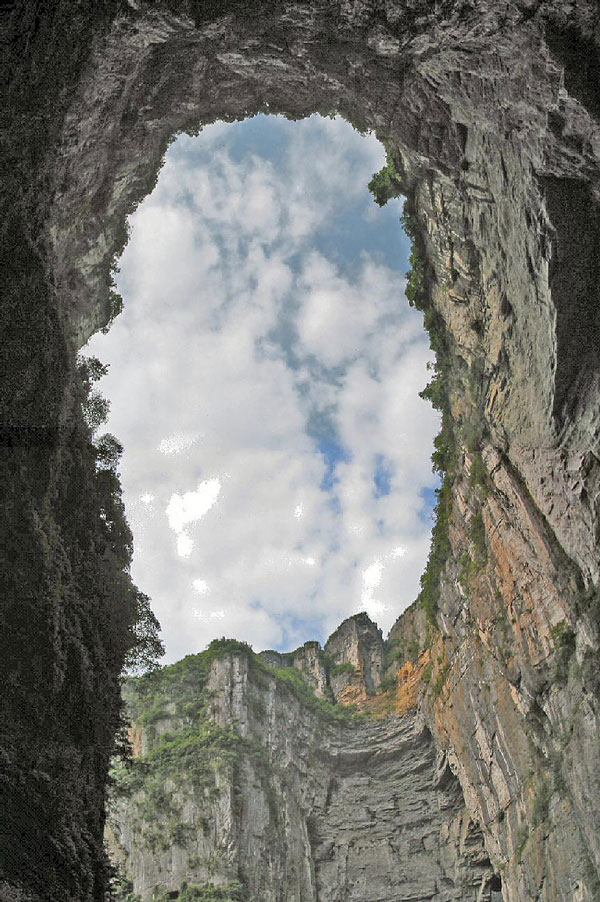
Fig. 14. Shenying Tiankeng, between the natural bridges in Wulong.
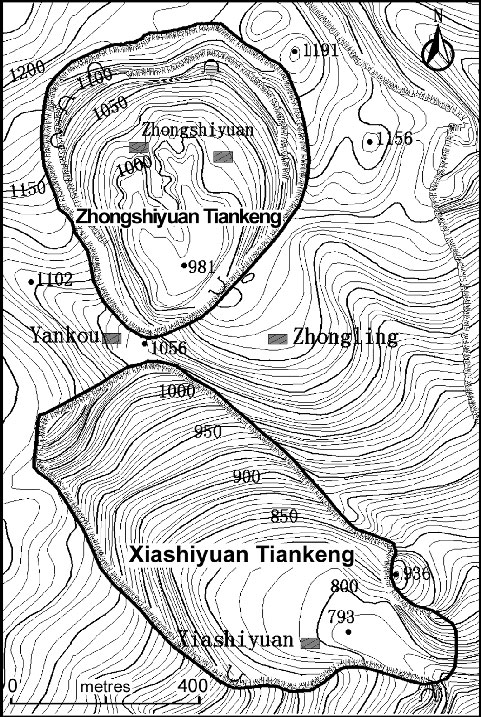
Fig. 15. The adjacent tiankengs of Zhongshiyuan and Xiashiyuan, Wulong.
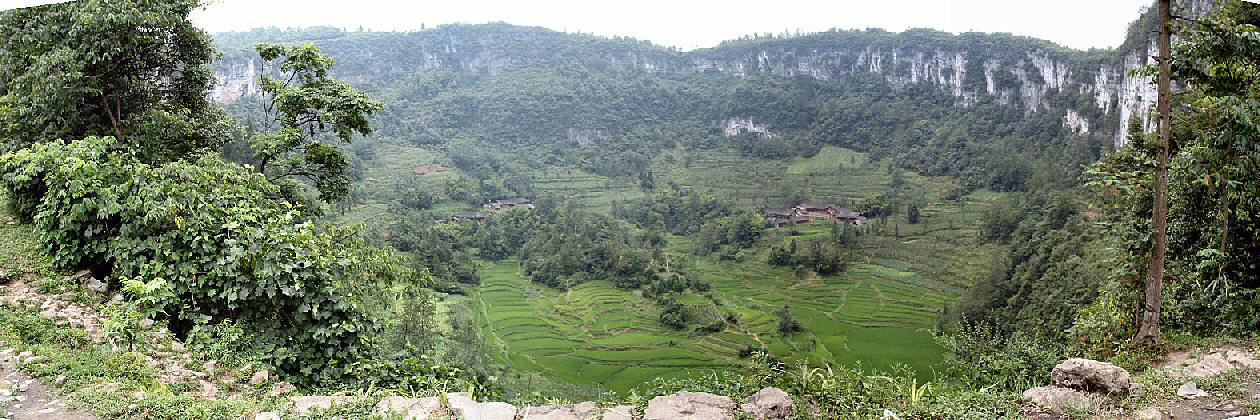
Fig. 16. Zhongshiyuan Tiankeng, Wulong.
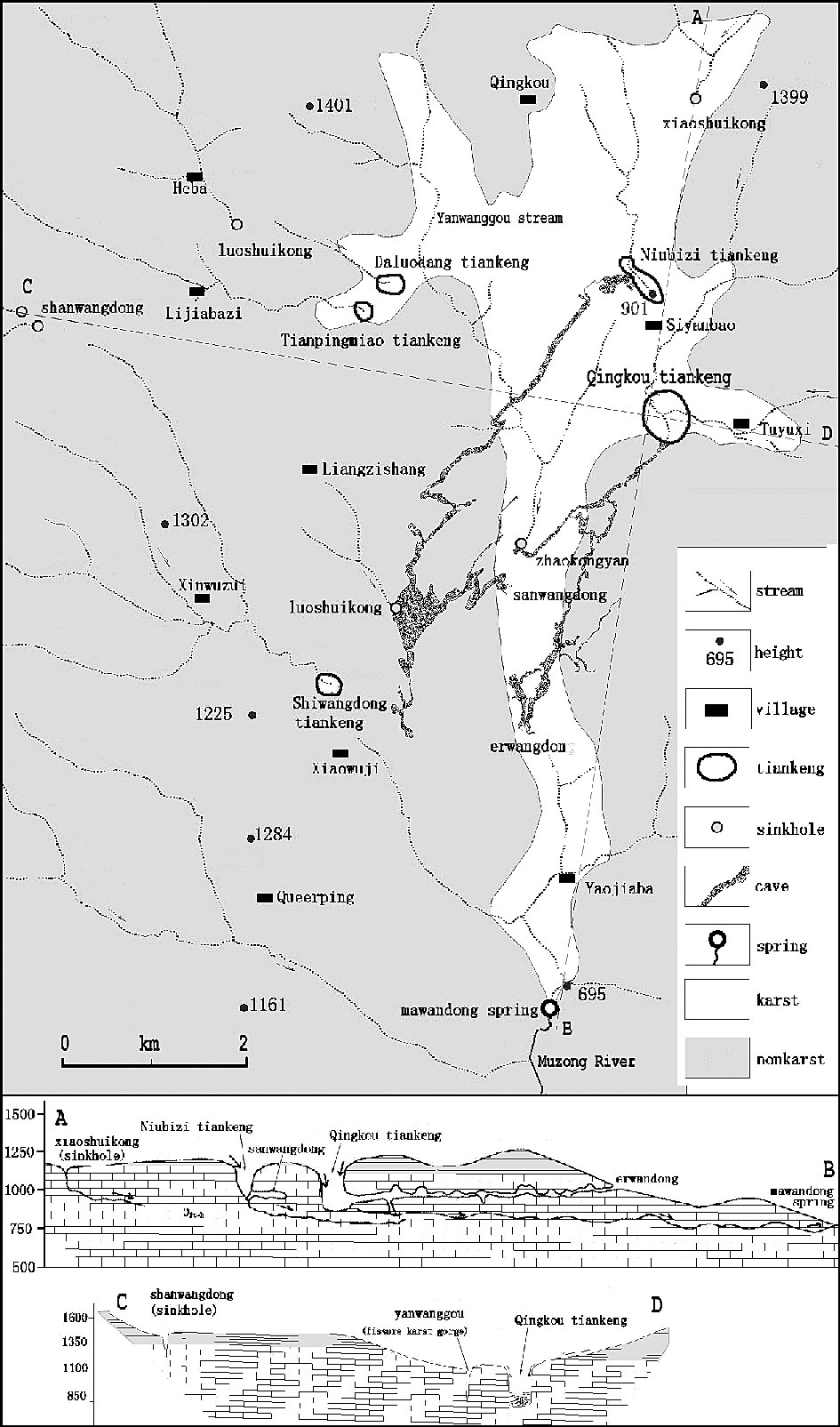
Fig. 17. Hydrogeology of the Qingkou tiankeng group in the Wulong karst.
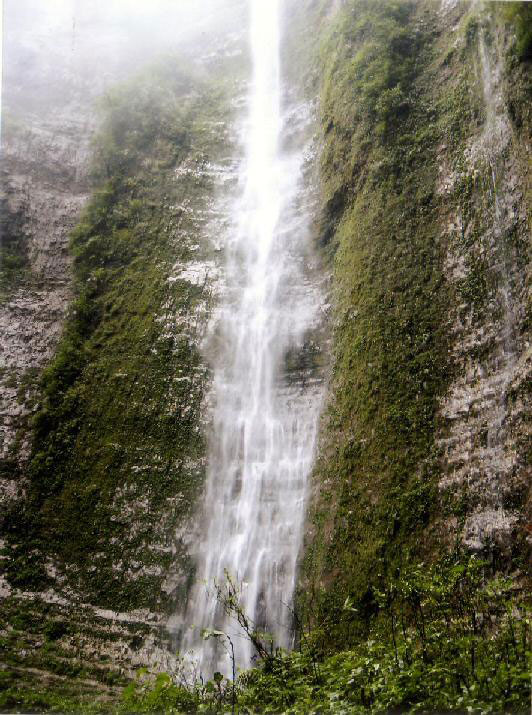
Fig. 18. The waterfall down into Qingkou Tiankeng.
Tiankengs in Guizhou
For many years there was limited data on the karst landforms, and especially on tiankengs, in Guizhou, but a number of tiankengs in the karst of the Meng Jiang river basin on the left bank of the Hongshui River (Fig. 19) have now been recorded.
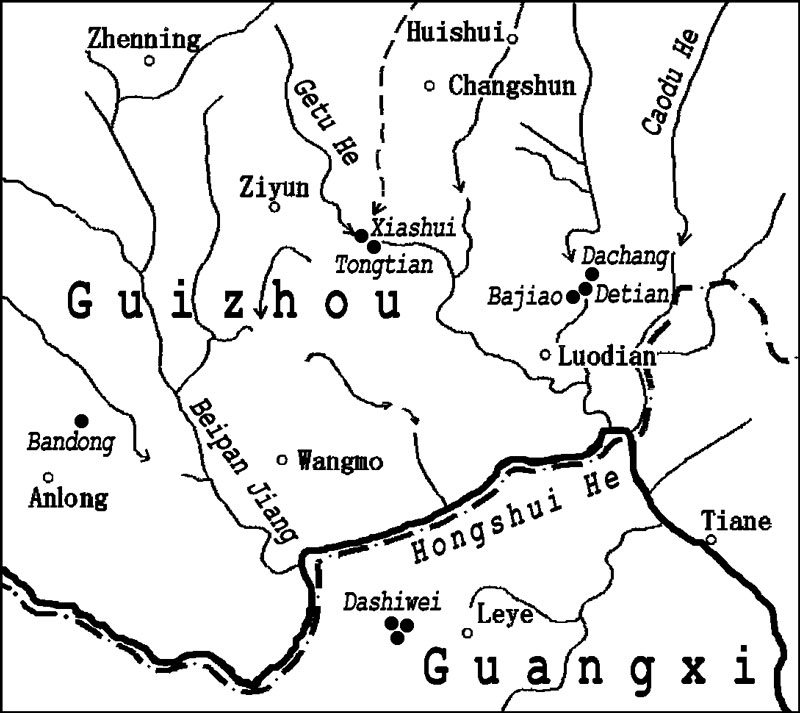
Fig. 19. Locations of tiankengs on both sides of the Hongshui River.
The Dongdang tiankeng group lies in thick, massive, Triassic limestone along the course of the Daxiaojin underground river in Luodian county. Detiandong Tiankeng lies in a hillside in cone karst, 300 m from the exit of Dajin underground river; it is 130-192 m across and 145 m deep, with steep walls and a floor of collapsed rocks. An adjacent shaft is separated from it by a natural bridge, and a cave at its foot connects with the Dajin Underground River. Dachang Tiankeng also lies in a hillside in cone karst, and also has a cave passage connecting it to the Dajin Underground River about 1 km from the exit; it is 180-500 m across and 320 m deep, with a sloping floor of rock collapse debris. Bajiao Tiankeng forms a large skylight into the old high-level passages of Xiangshui Dong. Its entrance is nearly 200x300 m in plan and is 230 m deep, with vertical walls to a floor of breakdown debris (Zhang and Barbary, 1988); an adjacent smaller tiankeng, 100x150 m in plan, connects into the same cave.
The Shuitang tiankeng group lies in the Getuhe cave tourism scenic area formed in thick, massive, Middle Carboniferous limestone in Ziyun County. Tongtian Tiankeng lies just above the sink entrance of the Getu Underground River; its entrance is 200 m across and it drops 370 m with largely vertical walls to a ramp down to the underground river (Barbary et al, 1991). Nearby, Xiaoshui Tiankeng is over 100 m in diameter and drops 210 m straight into the downstream passage of the Getuhe Cave, which also contains the very large Miao chamber.
The Dacaokou and Xiaocaokou Tiankengs are in Zhijin county in central Guizhou, within the Chang Jiang catchment. They lie between two short sections of cave and a massive natural bridge, all traversed by the Yijie River (Zhang & Barbary, 1988), and the site is similar to that at Sanqiao in Chongqing. Dacaokou is the larger of the two tiankengs, over 900 m long, with vertical cliffs above scree ramparts that close to each bank of the river. Bandong Tiankeng is a major collapse in Anlong county; it drops into an inactive cave system that extends through to the Anhe mega-doline and also contains Titan Chamber, 300 m long and 150 m wide (Dunton and Laverty, 1993).
Within Guizhou, 73% of the land is karst, developed on carbonate rocks of more than 1200 m thick that range from Sinian (Precambrian) to Triassic in age. However, tiankengs are not widely distributed, since many parts have disadvantageous conditions, including thicknesses of pure, continuous carbonate rocks of less than 100 m due to non-karst interlayers of sandstone, shale, and mudstone, complicated geological structure, changeable structural dips, and shortage of trunk rivers along the watershed between the Yangtze and Pearl rivers. Conditions advantageous to tiankeng development are cone karst, dissected by rivers to create a vadose zone more than 100 m deep in gently dipping, continuous carbonate sequences more than 100 m thick. It is therefore expected that more tiankengs could be formed in the dissected areas of the Wu Jiang drainage basin in northern Guizhou and also along the southern edge of the Guizhou plateau, especially over the courses of major underground rivers.
Discussion
Dolines and tiankengs
A doline is a natural, closed depression in a karst terrain (it is generally called a sinkhole in North America). It is usually close to circular or polygonal in surface shape, with a diameter of tens to hundreds of metres and a depth of metres to tens of metres (Fig. 20); its shape is generally that of a rounded bowl or an inverted cone, and it is always formed in or over soluble rocks (Williams, 2004).
Dolines can be classified into six main types - solution, collapse, caprock, dropout, suffosion and buried dolines (Fig. 21), though the dropout and suffosion dolines are two types of subsidence doline (Waltham et al, 2005). It is significant that any doline is clearly related to fissures or caves in soluble rocks beneath it. The doline is one of the main karst landforms in the karst areas of strong, pre-Triassic carbonate rocks in China, especially in the humid subtropical karst south of the Yangtze River. The most abundant are solution dolines, notably well developed in the fengcong cone karst and in the mountain karst belts. The second most common are the dropout dolines formed in the clay-rich cover soils, especially in the alluvial plains of the between towers in the fenglin karst; many are formed naturally, but many have been induced by pumped abstraction of underground water, mine drainage and other disturbing factors. Collapse dolines in bare karst are relatively few in number.
A tiankeng is a large negative landform in a specific type of karst terrain. It is generally roughly round or oval in plan shape, with very steep, vertical or overhanging walls (so that the area of its floor is similar to that of its surface footprint), and there is a clear break between the foot of its walls and its floor. Tiankengs are 100 m to 1000 m in diameter, and >100 m deep; the deepest reaches a depth of nearly 700 m. Most tiankengs are essentially very large collapse dolines, though a few may relate to very large caprock dolines (Fig. 21).
Current research suggests that tiankengs in carbonate rocks may be divided into two types - collapse tiankengs and erosional tiankengs. The former are much more widespread and numerous than the latter (Zhu et al, 2003a, 2003b, 2004).
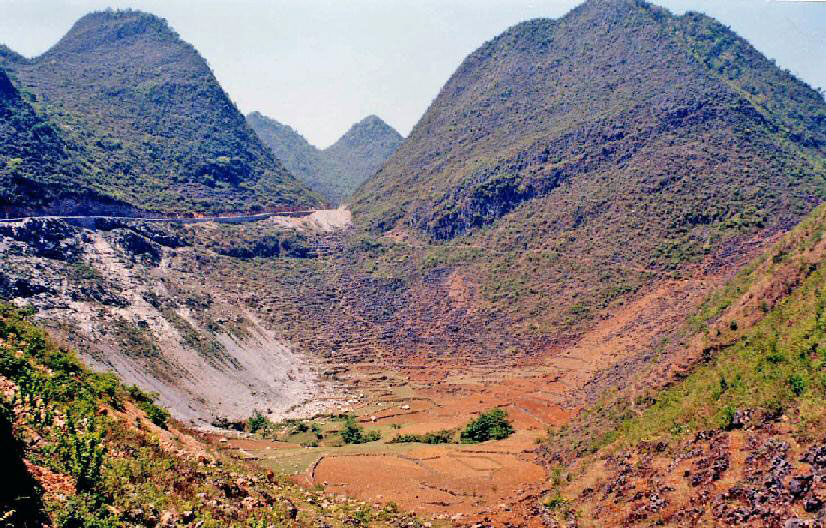
Fig. 20. A typical normal doline in fengcong karst.
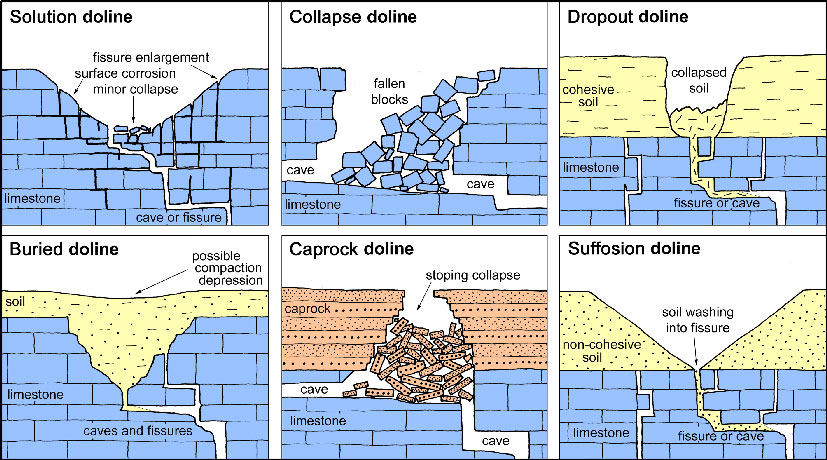
Fig. 21. The six types of doline (from Waltham et al, 2005).
Collapse tiankengs
Collapse tiankengs have been formed in soluble rocks where massive amounts of rock material have been dissolved and eroded away at depth by a powerful and dynamic underground drainage system, notably through a large cave river passage. Under specific geologic and hydrogeological conditions, a cave chamber evolved as its roof failed gradually while the fallen rock debris was carried away by water; eventually, the chamber roof opened out to the ground surface. A collapse tiankeng is characterized as follows:
- It is ringed by steep or precipitous cliffs, which originated when it collapsed into a roughly conical void; it may have a collapsed triangular profile, a striking feature of many tiankengs. It normally has a clean break at the foot of the perimeter walls, though a gentle slope formed by later debris accumulation is a mark of relatively old age in a tiankeng.
- The floor of the tiankeng is composed mainly of boulders and breakdown blocks. Where there is an active cave river at the bottom, most colluvial debris and breakdown has been carried away, so that the cave river channel is exposed across the tiankeng floor. Alternatively, the colluvium thickness is smaller where the tiankeng is in a depression, or where colluvium remains in high terraces. Where breakdown is banked against the marginal cliffs, collapse is a continuing process. Where there is a great thickness of accumulated debris, forming a gentle slope or covered by sand and clay, the course of the underground river has changed, and debris transport through the cave conduit has basically stopped.
- A subterranean river flowing through the bottom is an essential feature of a collapse tiankeng, for it is the cave river that is the dynamic source of dissolution and erosion and carries away a great deal of the breakdown material (Fig. 22). An old tiankeng may have lost its underground river, and may retain its vertical walls before they start to degrade.
- Tiankengs of different sizes or different stages have distinctive morphologic features. The smaller or more youthful tiankengs are usually shaped like an inverted cone, i.e. the ratio (M) of the area of the surface entrance to that of the floor is less than 1 (M<1). Larger tiankengs are like a well with walls close to vertical, where M≈1. Very large tiankengs mostly have profiles that approach those of a doline, where M>1.
- An important feature of collapse tiankengs is that there is no relationship between the tiankeng entrance position and the surrounding surface geomorphology and karst landforms. A collapse tiankeng can develop in any terrain location, and it always destroys the surface karst landform as it evolves and expands. A collapse tiankeng can destroy depressions, dolines, wind gaps, blind valleys and any positive landforms, because it develops from underground towards the ground surface.
- There are three main stages of development in a tiankeng - a cave with a large river passage, then a large cave chamber, then a tiankeng that is open to the surface.
- The skylight collapse tiankeng, such as Huangjing Tiankeng in the Dashiwei group, is a variety of collapse tiankeng developed in carbonate rocks covered by thin sandstone. It has a flat floor because there is a flow of allogenic surface water carrying in sand and clay sediments that cover the breakdown debris. This is a type of tiankeng formed essentially by collapse but then modified in the style of an erosional tiankeng. Allogenic water has contributed to its present morphology, but the bulk of the feature was developed as an underground cave chamber before collapse breached its roof and also the thin sandstone cap.
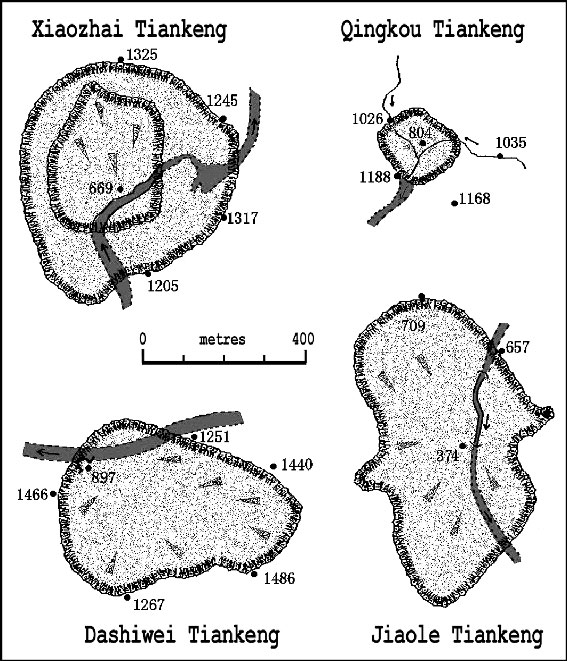
Fig. 22. Streams and rivers draining across the floors of four major tiankengs; three are collapse tiankengs, but Qingkou is an erosional tiankeng.
Erosional tiankengs
This second type of tiankeng is developed in the vadose zone of soluble rocks by allogenic water that dissolves and erodes the rock in its vertical descent from the surface. They are rare because of their special environmental conditions, but are characterized as follows:
- There may be a stream falling down the steep or vertical wall, or there are erosional features or hanging tufa deposits. However, there is not necessarily a perennial flow of water vertically into the tiankeng. It is unusual to have either a collapse triangular profile or any great amount of collapse debris on the floor.
- In contrast to the development of collapse tiankengs where the surface hole opened abruptly from beneath, erosional tiankengs are formed gradually from the surface to the floor. Excavation downwards by stream erosion, and fluvial removal of debris and solutes, complement each other.
- An erosional tiankeng lies at the head of an underground river, and there is generally a large inlet cave entrance in one side of the tiankeng.
- Erosion and dissolution are the primary and dominant processes that excavate an erosional tiankeng, in contrast to the importance of collapse in the development of collapse tiankengs. An erosional tiankeng has development stages that differ from those of a collapse tiankeng; it starts with a stream sink into a conduit, and this enlarges gradually, and then deepens and widens into a tiankeng.
- Erosional tiankeng develop at the boundary between soluble and non-soluble rocks, and can be classified into two types by their geological structure - in horizontal beds, such as Qingkou Tiankeng, and in dipping beds, such as Garden of Eden in Sarawak. The Huangjing skylight tiankeng formed under a sandstone caprock, but developed largely by collapse before the allogenic water could reach it, and is therefore classified as a collapse tiankeng.
Morphological contrasts between dolines and tiankengs
The main features of a tiankeng are its very large size (>100 m wide and deep) and its perimeter walls that are close to vertical. In contrast, most bedrock dolines in karst are bowls or shallow basins where the width is greater than the depth; some have steeper profiles and a depth similar to their width, but they are much smaller than a tiankeng.
The profile of a tiankeng has a clear break between its walls and its floor, while most karst dolines do not. A tiankeng has steep walls, a thick layer of collapse breakdown on its floor, and also a large underground conduit flow, while the karst doline typically has gentle slopes, thick soil on its floor, and a small stream sink.
The development of dolines in karst is closely related to the surrounding surface topography, the negative doline always being in harmony with the positive landforms. Collapse tiankengs develop with no direct relationship to surface landforms, as they form anywhere and destroy any other landforms of the surface karst, including dry valleys, depressions, dolines or cone karst, either individually or collectively.
Most dolines in bedrock formed in the epikarst and shallow vadose zone by rainfall dissolution, without any direct relationship to the aquifer and its cave rivers. Tiankengs developed within deep unsaturated zones, by active conduit flow within the aquifer aided by concentrated surface inflow. Collapse tiankengs and erosional tiankengs formed by underground flow and surface river flow respectively, and both are directly related to large underground conduit flows in the aquifer.
The development of the common solution doline is a long slow process that proceeded as part of long-term karst landform evolution. In contrast, tiankeng development is mostly abrupt, in the case of a collapse tiankeng, or relatively rapid in the case of an erosional tiankeng. Tiankengs are generally among the youngest of large negative karst landforms.
Nomenclature and definition of tiankengs
Tiankengs have different names in different parts of the world, but the terms are synonymous. In China, they are called yanwan, shiyuan, longgang, shiwei, tiankeng, karst tiankeng, cao, dong, dang among other terms, that all have the similar meanings of big pit, deep doline or collapsed doline. In Slovenia, they are called kukave, kolisevye, vigedi or various other terms, and in Mexico they are called sotanos. It is proposed that tiankeng becomes the international term.
The definition of a tiankeng
Based on the research and conclusions outlined above, it is proposed that the definition of a tiankeng is - "a large, steep-walled, pit-like, negative, karst landform that opened from beneath towards the surface, with both its depth and diameter more than 100 m, developed in a great thickness of continuous soluble rocks within a deep vadose zone of the aquifer and connecting with an active cave river at its foot". A tiankeng is characterized by its tourism values of rarity, grandeur and spectacular magnificence, and also by its special ecological environment. These are all characteristics that differentiate between tiankengs and normal karst dolines.
The tiankengs recognized throughout the world to date had been classified into four size groups - oversize, large, medium and small (Zhu et al, 2003). But it is now proposed (in accord with Zhu & Waltham in this volume) that those in the smallest group are no longer defined as tiankengs as they are <100 m deep and wide. The nomenclature is therefore adjusted so that there are three size groups -
- Very large tiankengs, more than 500-600 m in diameter and depth, are very rare worldwide, and there are only three known so far in China - Xiaozhai, Dashiwei and Haolong.
- Large tiankengs, 300-500 m in diameter and depth, are also few in number around the world.
- Normal tiankengs, 100-300 m in diameter and depth, are more numerous and more widely distributed.
Development environments of tiankengs
Collapse and erosional tiankengs have some features in common, but also have some important differences in their development conditions. There are five essential environmental conditions.
- A great and continuous thickness of soluble rocks. Soluble sedimentary rock (generally carbonate rocks in China) is the first requirement for tiankeng development. The large and deep tiankengs have developed within the larger thicknesses of soluble rock that are unbroken by any significant impermeable interbeds, so allowing the establishment of a unified vadose zone within the aquifer.
- A deep vadose zone in the karst. Tiankengs have largely developed in the vadose zone of an aquifer above a deeply buried water table, where the depth of the vadose zone is nearly equal to or greater than the depth of the tiankeng. Tectonic uplift and rejuvenation caused entrenchment of the surface rivers and a major lowering of the regional water table, thereby increasing the depth of the vadose zone. Tiankengs are most common in areas of tectonic uplift.
- A favorable geological structure. The two kinds of tiankeng are formed mainly in karst regions with gently dipping or horizontal rocks which have wide outcrops. Structural fissures, notably long and deep faults and vertical joints allow development of strong hydrodynamic systems in the aquifer. A structure with gently dipping beds and networks of joints and faults favors progressive breakdown of the roof of large cave chambers at depth. Dipping beds are eroded to outcrops with long contacts to insoluble rocks, and so favor development by allogenic drainage of erosional tiankengs, including Qingkou tiankeng.
- A highly active hydrodynamic system with underground conduit flow in cave rivers. A tiankeng is one of the largest closed and negative landforms in karst, involving the removal of up to 1000M m3 of rock by breakdown, dissolution and fluvial transport. This clearly requires a powerful hydrodynamic system in the form of active conduit flow within a cave river system in the karst aquifer. The known tiankengs have all developed in association with major underground river systems. The cave river is the critical factor in tiankeng development, including for erosional tiankengs - where the river is the result of the tiankeng development and not its precondition.
- Favorable climate and hydrogeology. A humid and rainy climate supplies plentiful rainfall and biogenic carbon dioxide for dissolution and river flow, and encourages high erosional intensity and a high rate of tiankeng development. Tiankeng distribution is related to the zones of humid climate and abundant precipitation.
These environmental factors are all optimally developed in the karst of southern China, especially in the cone karst areas with high relief - which include the most important tiankeng sites in the world.
The geological age of tiankengs
Tiankengs provide data for research of karstification intensities and rates, and offer a new way to study time-scales of karst geological process. The features below are the key to discussion and understanding of tiankengs:
- Tiankeng development requires the removal of massive volumes of rock. The largest known tiankengs, in terms of volume and rock tonnage removed, are Xiaozhai (Chongqing, China), 1.2×108 m3, 3.22×108 tonnes, and Garden of Eden (Mulu, Sarawak), 1.5×108 m3, 4.05×108 tons (though the Garden of Eden is an old feature that has been enlarged by fluvial erosion during its degradation, and is now best regarded as a mega-doline).
- Depths of tiankengs are close to the thicknesses of the local vadose zone, so that they reach down to the karst water table. The deepest is Xiaozhai Tiankeng, 662 m deep (Fig. 23).
- Collapse tiankengs have developed in any location among the surface landforms, thereby destroying any negative or positive karst landforms of greater age.
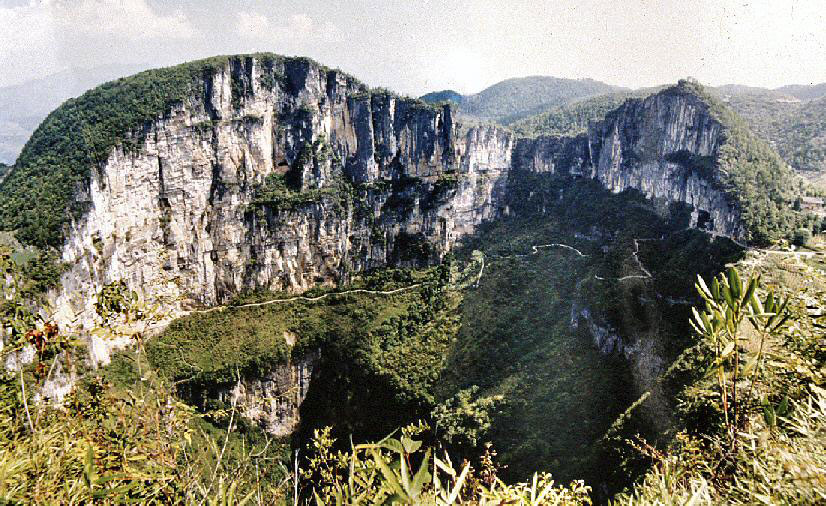
Fig. 23. The very large and very deep Xiaozhai Tiankeng.
It is suggested that the tiankengs in China are among the youngest negative landforms of the karst. Ongoing research is relating the high intensities and rates of karstification to the relatively young geologic ages of the tiankengs. Tectonic uplift of the karst region of southern China dates only from the Himalayan orogeny in the early Quaternary. This caused the deep incision by surface trunk rivers (including the Yangtze, the Wu and the Hongshsui, each with their deep gorge sections), and the consequent decline of the karst water table (and increase in vadose zone thickness) caused development of the underground rivers and formation of the tiankengs. This suggests that the tiankengs in China formed mainly in the late Pleistocene, within the last 128,000 years.
The active tiankengs whose underground rivers have not switched to newer routes, such as Xiaozhai and Dashiwei, may have been open to the surface only for some tens of thousand of years. It is probable that the large cave chambers developed at these sites at much earlier ages (as they normally evolve over very long time-scales), when the ground surface was higher, and only the surface collapse (when the cave chambers evolved into open tiankengs) was a Holocene process at some sites.
Conclusion
The doline is one of the most familiar and distinctive landforms in karst terrains. There are several doline types that form in soluble rock terrains (mainly of carbonate rock and gypsum), including the solution, collapse and subsidence dolines. Collapse dolines are karst bedrock collapses (and caprock dolines involve collapse of insoluble rock that covers a buried karst), but the sizes of all dolines do not match the size of a tiankeng. Dolines in carbonate rocks generally have diameters and depths up to about 100 m. Very large, vertical-walled, karst depressions differ from all the main doline types, though some have been called just large dolines or large collapse dolines. These are distinguished by not only their size but also by their development mechanisms and conditions, so it is proposed that they should be separated from dolines and referred to as tiankengs.
Distinctive features of a tiankeng
A very large doline is now called a tiankeng for certain basic reasons:
- A tiankeng develops in special environmental conditions that integrate aspects of geology, geomorphology and hydrogeology, but a normal doline develops in a much wider range of karst environments. Consequently, dolines and collapse dolines are widespread while tiankengs are very few within the world's karst.
- A tiankeng differs greatly from dolines and collapse dolines in its development and erosional mechanisms. A collapse doline forms by dissolution and suffosion in normal geological and hydrodynamic environments. Collapse tiankengs have developed through an unusual hydrodynamic combination of erosion, dissolution and collapse, where three evolutionary stages may be distinguished, from a cave river passage, to a large cave chamber, to a tiankeng open to the surface.
- A tiankeng is very much larger than a normal collapse doline. It is more than 100,000 m3 in volume, 1000-100,000 m2 in area at both the surface level and its floor, and more than 100 m in depth.
- A tiankeng differs from normal dolines in its development processes. Tiankengs have close relationships with the regional development of cave river systems, and their distribution, evolution, age and development rates are not comparable to those of normal karst dolines.
The importance of the scientific study of tiankengs
The study of tiankengs has important scientific implications for karst hydrogeology and geomorphology, and for studies of karst processes and neotectonics.
Where tiankengs develop within a regional karst drainage system, they indicate the presence of a powerful karst hydrodynamic system, and they relate to the input and output balance of material and energy in a strong conduit flow or cave river in the karst aquifer. This can supply valuable data towards research into the basic characters of an aquifer and into the evolution and variance of conduit flow in drainage areas where tiankengs occur.
The evidence to date suggests that collapse tiankengs develop anywhere they can, and always destroy any surface karst landform, including depressions, dolines, wind-gaps, blind valleys, cones, hills, towers and any other positive landforms. It appears that tiankengs are among the younger karst landforms, and a negative feature of 10 to 100 million cubic meters volume developed in a short geological time gives us a new concept of intensity, mode and rate of karstification. It appears that the tiankengs of southern China have largely or entirely developed within the later Pleistocene, and the oldest tiankeng appears to be no more than 128,000 years old.
Finally, local neotectonic uplift appears to have contributed to the critical environment for tiankeng development. Conversely, tiankeng research can supply important information for the study of the rates and characteristics of neotectonic movement.
Acknowledgements
First of all, to our colleagues, Prof. Zhu Dehao, senior engineer Li Yusheng and Tan Kai?ou, as well as Zhang Yuanhai, Huang Baojian, Zhang Ren, Han Daoshan, Cai Wutian, Zhu Jinbo, Deng Yadong for their contribution to the tiankeng investigation and research, tiankeng data analysis and map compilation. Also to Prof. Yang Mingde of Guizhou Normal University for supplying tiankeng data in Guizhou, Andy Eavis for his great contribution to our tiankeng exploration as the international coordinator of the China Caves Project, Tony Waltham for his research cooperation on tiankengs inside and outside China, and the many cavers from Britain, Ireland, USA, Australia, Italy, France, and Switzerland who have enriched the paper by supplying their cave surveys and data. This text was translated from Chinese by Zhang Yuanhai and Zhu Xuewen, and the grammar was edited by Tony Waltham.
References
- Barbary, J, Maire, R and Zhang S, 1991 Gebihe 89 karsts de Chine. Karstologia Memoires, 4, 232pp.
- Dunton, B and Laverty, M, 1993. The caves of Doshan, Guizhou, China. Cave Science, 20, 65-71.
- Garasic, M, 2001. New speleo-hydrogeological research of Crveno jezero (Red Lake) near Imotski in Dinaric karst area (Croatia, Europe). Proc. 13th Internat. Cong. Speleology, Brazil, 2, 168-171.
- Senior, K J (ed.), 1995. The Yangtze Gorges Expedition: China Caves Project 1994. Cave and Karst Science, 22(2), 53-89.
- Waltham, A C and Willis, R G, 1993. Xingwen: China Caves Project 1989-1992. British Cave Research Association: Bridgewater, 48pp.
- Waltham. T, Bell, F and Culshaw, M, 2005. Sinkholes and Subsidence. Springer: Berlin, 382pp.
- Waltham, T, Brook, D and Bottrell, S, 1993. The caves and karst of Xingwen, China. Cave Science, 20(3), 75-86.
- Williams, P, 2004. Dolines. 304-310 in Gunn, J (ed.), Encyclopedia of Caves and Karst Science. Fitzroy Dearborn: New York.
- Zhang S and Barbary, J, 1988. Guizhou Expe 86. Spelunca Memoires, 16, 108pp.
- Zhu Xuewen. 2001. China's karst tiankeng and its value for science and tourism. Science & Technology Review, 10(160), 60-63 (in Chinese).
- Zhu Xuewen, Zhu Dehao and Chen Weihai, 2003a. A brief study on karst tiankeng. Carsologica Sinica, 22(1), 51-65 (in Chinese).
- Zhu Xuewen, Huang Baojian, Zhu Dehao and Chen Weihai, 2003b. Dashiwei Tiankeng Group, Leye, Guangxi: discoveries, exploration, definition and research. Guangxi Scientific & Technical Publishers (and China International Publishes: Beijing), 184pp (in Chinese with English summary).
- Zhu Xuewen, Zhang Ren, Zhang Yuanhai and Han Daoshan, 1995. Karst and caves in Xingwen stone forest area, Sichuan. Carsologica Sinica, 14(suppl.), 28-48 (in Chinese).


